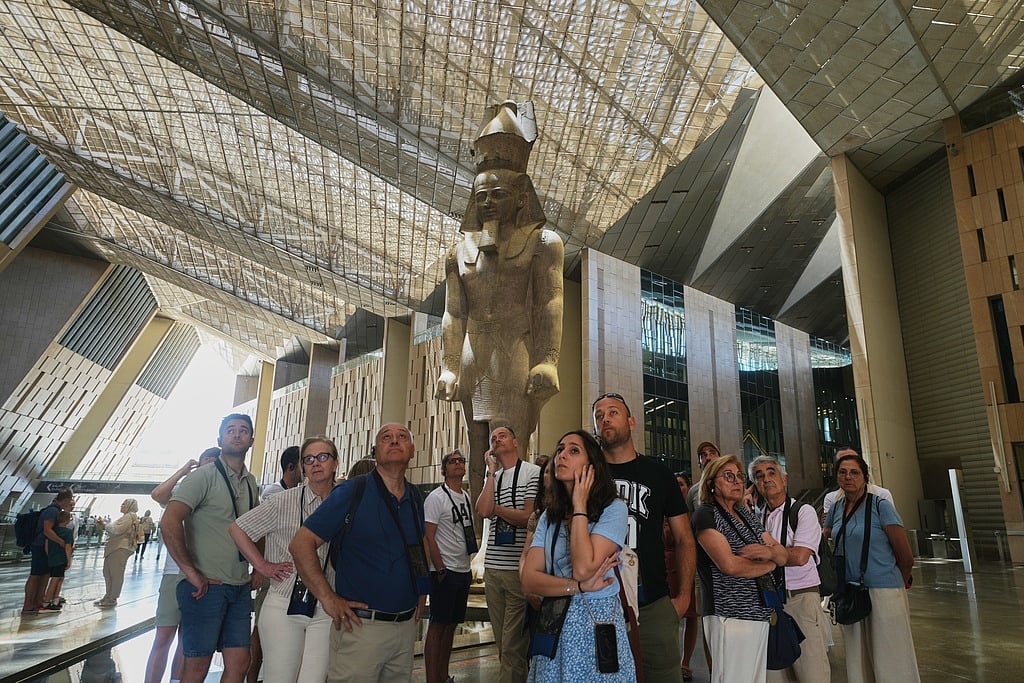Cairo: After two decades of anticipation and countless delays, the Grand Egyptian Museum is finally having its grand reveal.
The museum, which is set to officially open Saturday, highlights Egypt’s ancient civilisation and is a centrepiece of the government’s drive to boost the tourist industry, a major source of foreign currency in the cash-strapped country.
Located just outside Cairo next to the famed Giza Pyramids, the $1 billion mammoth facility is poised to become the world’s largest museum dedicated to a single civilisation with over 50,000 artefacts detailing the life in ancient Egypt. By comparison, the Louvre Museum in Paris has about 35,000 pieces on display.
The museum is one of the mega-projects championed by President Abdel Fattah El Sisi, who since taking office in 2014 embarked on massive investments in infrastructure with the aim of reviving the economy.
The museum’s construction began in 2005, but work stopped for three years.
The grand opening was postponed multiple times, most recently in July this year because of conflicts in the Middle East. World leaders are expected to attend the opening ceremony Saturday.
Giant building with a view of the Giza Pyramids
Designed by the Irish firm Heneghan Peng Architects, the museum, known as GEM, boasts a towering, triangular glass façade imitating the nearby pyramids.
In its entrance atrium stands the granite colossus of one of Egypt’s most famed pharaohs, Ramesses the Great. The 3,200-year-old, 11-metres-tall (36-foot-tall) statue was moved to the museum after decades of standing in the centre of a traffic-clogged roundabout in front of Cairo’s main train station.
From the atrium, a grand six-storey staircase lined with ancient statues leads up to the main galleries and a view of the nearby pyramids. A bridge links the museum to the pyramids, allowing tourists to move between them either on foot or via electric, environment-friendly vehicles, according to museum officials.
The museum includes 24,000 square metres (258,000 square feet) of permanent exhibition space, a children’s museum and conference and educational facilities, and a commercial area as well as a large conservation centre.
The 12 main galleries, which opened last year, exhibit antiquities spanning from prehistoric times to the Roman era, organised by era and by themes.
Many of the 50,000 artefacts in the GEM were moved from the Egyptian Museum, a packed, century-old building in downtown Cairo’s Tahrir Square. Others were recently unearthed from ancient cemeteries, including the Saqqara necropolis, another complex of pyramids and tombs about 22 kilometres south of the museum.
The halls are equipped with advanced technology and feature multimedia presentations including mixed-reality shows to help explain ancient Egypt to new generations, said Ahmed Ghoneim, the museum’s CEO.
“We’re using the language that the Gen Z uses right now,” he said in an interview. “Gen Z doesn’t use anymore the labels that we read as old people but rather use technology.”
Tutankhamun collection in one place for the first time
Saturday’s grand opening will include the inauguration of two halls dedicated to the 5,000 artefacts from the collection of King Tutankhamun.
The collection is being displayed in its entirety for the first time since British archaeologist Howard Carter discovered King Tut’s tomb in 1922 in the southern city of Luxor. The old Egyptian Museum didn’t have enough space to show all the tomb’s treasures at once.
Some masterpieces were restored at the museum’s conservation centre, including the boy pharaoh’s three funeral beds and six chariots, said Jailan Mohamed, chief restorer at the conservation centre.
They will be displayed along with his golden throne, his gold-covered sarcophagus and his burial mask, made of gold, quartzite, lapis lazuli and coloured glass. The mask’s beard was accidentally knocked off and hastily glued back on with epoxy in 2014, before a German-Egyptian team of experts fixed it the following year.
Another centrepiece of the museum is the 4,600-year-old solar boat of King Khufu, the pharaoh who is credited with building the Great Pyramid of Giza. The 43-metre-long (140-foot) wooden boat, discovered in the 1950s, was buried next to the Great Pyramid for Khufu - or Cheops as he is also known - to use in the afterlife. In 2021, it was moved from its display site by the pyramids into the Grand Egyptian Museum on a remote-controlled vehicle imported from Belgium.
Revive tourism
The government hopes the museum will draw more tourists who will stay for a while and provide the foreign currency Egypt needs to shore up its economy.
In recent years, the sector has started to recover from the coronavirus pandemic, and the effects of Russia’s war on Ukraine. Both Russia and Ukraine are a major source of tourists visiting Egypt.
A record number of 15.7 million visited the country in 2024, according to official figures, and the government aims to attract 30 million visitors by 2032.
Authorities overhauled the whole area around the museum and the pyramids. Roads were paved and a metro station is being constructed outside the museum gates to ease access to the sites. An airport, Sphinx International Airport, was also opened west of Cairo - 40 minutes from the museum.
Hassan Allam, CEO of Hassan Allam Holding, the firm operating the museum, said they’re expecting between 15,000 and 20,000 visitors a day at the museum.
“The world has been waiting... Everyone’s excited,” he said.
Sign up for the Daily Briefing
Get the latest news and updates straight to your inbox
Network Links
GN StoreDownload our app
© Al Nisr Publishing LLC 2025. All rights reserved.
